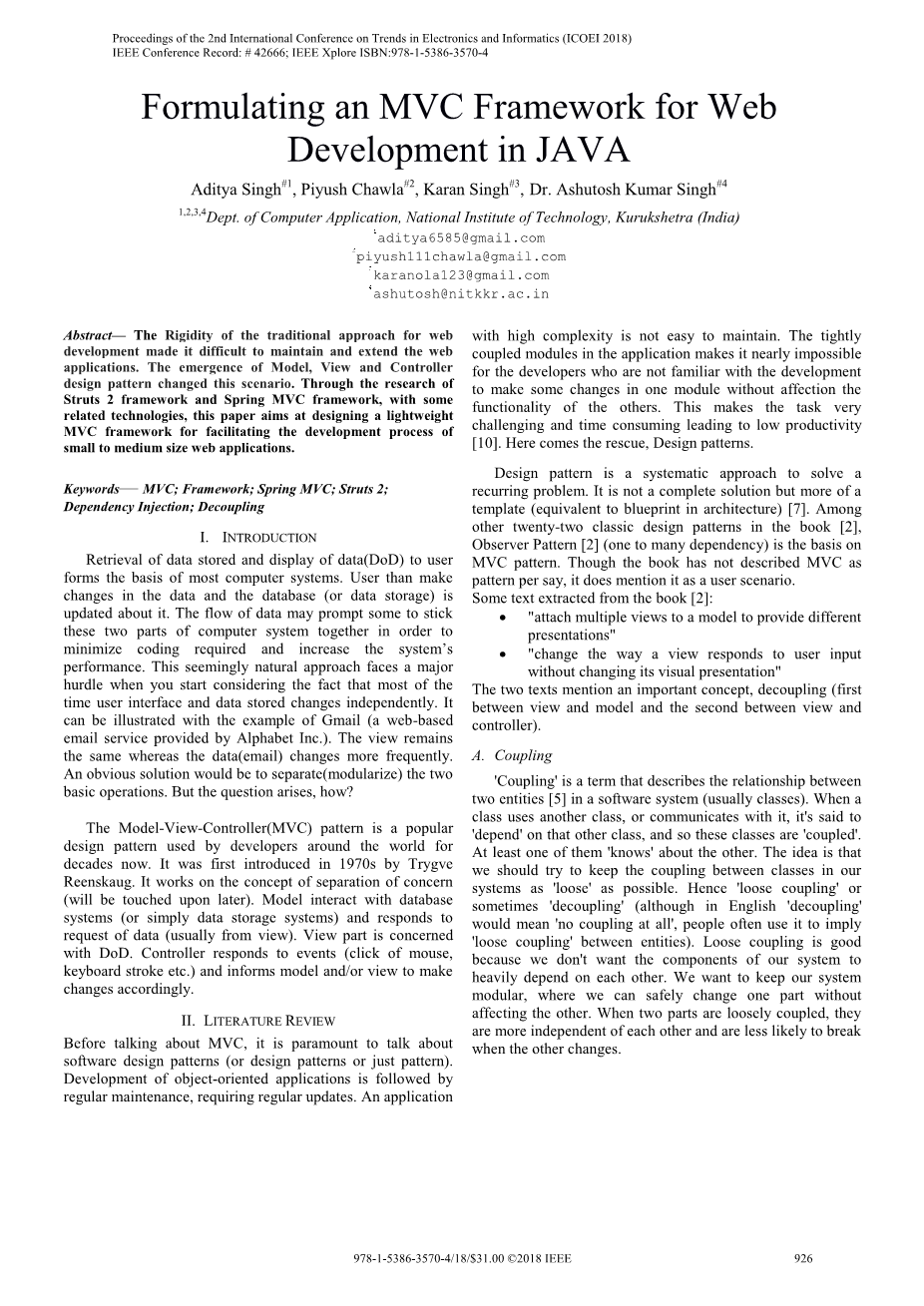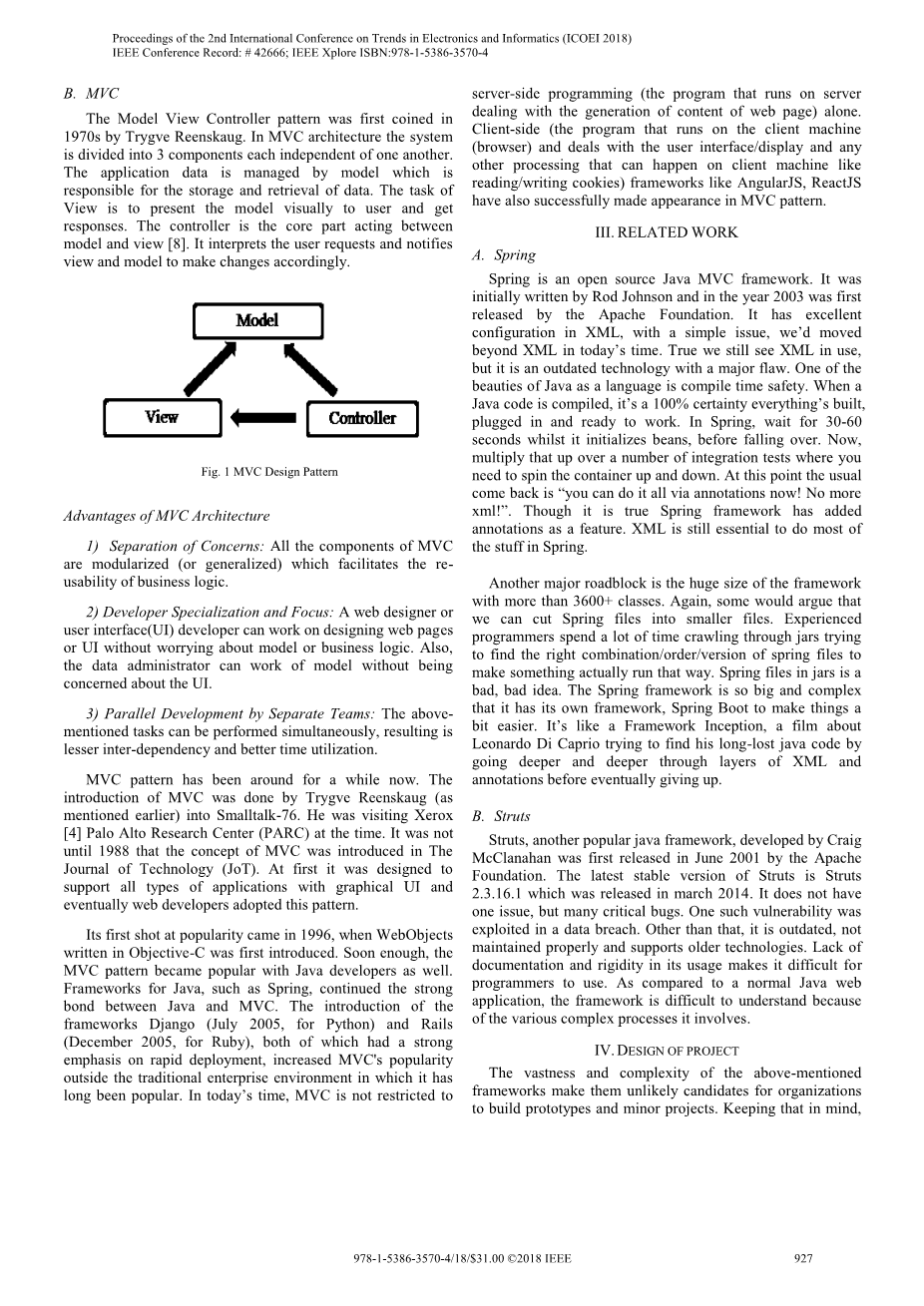英语原文共 4 页,剩余内容已隐藏,支付完成后下载完整资料
Formulating an MVC Framework for WebDevelopment in JAVA
Aditya Singh #1 , Piyush Chawla #2 , Karan Singh #3 , Dr. Ashutosh Kumar Singh #4 1,2,3,4 Dept. of Computer Application, National Institute of Technology, Kurukshetra (India)
Abstract— The Rigidity of the traditional approach for webdevelopment made it difficult to maintain and extend the webapplications. The emergence of Model, View and Controllerdesign pattern changed this scenario. Through the research ofStruts 2 framework and Spring MVC framework, with somerelated technologies, this paper aims at designing a lightweightMVC framework for facilitating the development process ofsmall to medium size web applications.
Keywords — MVC; Framework; Spring MVC; Struts 2;Dependency Injection; Decoupling
I. I NTRODUCTION
Retrieval of data stored and display of data(DoD) to userforms the basis of most computer systems. User than makechanges in the data and the database (or data storage) isupdated about it. The flow of data may prompt some to stickthese two parts of computer system together in order tominimize coding required and increase the systemrsquo;sperformance. This seemingly natural approach faces a majorhurdle when you start considering the fact that most of thetime user interface and data stored changes independently. Itcan be illustrated with the example of Gmail (a web-basedemail service provided by Alphabet Inc.). The view remainsthe same whereas the data(email) changes more frequently.An obvious solution would be to separate(modularize) the twobasic operations. But the question arises, how?The Model-View-Controller(MVC) pattern is a populardesign pattern used by developers around the world fordecades now. It was first introduced in 1970s by TrygveReenskaug. It works on the concept of separation of concern(will be touched upon later). Model interact with databasesystems (or simply data storage systems) and responds torequest of data (usually from view). View part is concernedwith DoD. Controller responds to events (click of mouse,keyboard stroke etc.) and informs model and/or view to make
changes accordingly.
II. L ITERATURE R EVIEW
Before talking about MVC, it is paramount to talk aboutsoftware design patterns (or design patterns or just pattern).Development of object-oriented applications is followed byregular maintenance, requiring regular updates. An applicationwith high complexity is not easy to maintain. The tightlycoupled modules in the application makes it nearly impossiblefor the developers who are not familiar with the developmentto make some changes in one module without affection thefunctionality of the others. This makes the task verychallenging and time consuming leading to low productivity[10]. Here comes the rescue, Design patterns.
Design pattern is a systematic approach to solve arecurring problem. It is not a complete solution but more of atemplate (equivalent to blueprint in architecture) [7]. Amongother twenty-two classic design patterns in the book [2],Observer Pattern [2] (one to many dependency) is the basis onMVC pattern. Though the book has not described MVC aspattern per say, it does mention it as a user scenario.Some text extracted from the book [2]:? 'attach multiple views to a model to provide differentpresentations' 'change the way a view responds to user inputwithout changing its visual presentation'The two texts mention an important concept, decoupling (first
between view and model and the second between view andcontroller).
A. Coupling
Coupling is a term that describes the relationship betweentwo entities [5] in a software system (usually classes). When aclass uses another class, or communicates with it, its said todepend on that other class, and so these classes are coupled.At least one of them knows about the other. The idea is thatwe should try to keep the coupling between classes in oursystems as loose as possible. Hence loose coupling orsometimes decoupling (although in English decouplingwould mean no coupling at all, people often use it to implyloose coupling between entities). Loose coupling is goodbecause we dont want the components of our system toheavily depend on each other. We want to keep our systemmodular, where we can safely change one part withoutaffecting the other. When two parts are loosely coupled, theyare more independent of each other and are less likely to breakwhen the other changes.B. MVCThe Model View Controller pattern was first coined in1970s by Trygve Reenskaug. In MVC architecture the system
is divided into 3 components each independent of one another.The application data is managed by model which isresponsible for the storage and retrieval of data. The task ofView is to present the model visually to user and getresponses. The controller is the core part acting between
model and view [8]. It interprets the user requests and notifiesview and model to make changes accordingly.Advantages of MVC Architecture
1) Separation of Concerns: All the components of MVCare modularized (or generalized) which facilitates the re-usability of business logic.
2) Developer Specialization and Focus: A web designer oruser interface(UI) developer can work on designing web pagesor UI without worrying about model or business logic. Also,the data administrator can work of model without beingconcerned about the UI.
3) Parallel Development by Separate Teams: The above-mentioned tasks can be performed simultaneously, resulting isesser inter-dependency and better time utilization.
MVC pattern has been around for a while now. Theintroduction of MVC was done by Trygve Reenskaug (asmentioned earlier) into Smalltalk-76. He was visiting Xerox
[4] Palo Alto Research Center (PARC) at the time. It was notuntil 1988 that the concept of MVC was introduced in TheJournal of Technology (JoT). At first it was designed to
support all types of applications with graphical
剩余内容已隐藏,支付完成后下载完整资料
资料编号:[409795],资料为PDF文档或Word文档,PDF文档可免费转换为Word
以上是毕业论文外文翻译,课题毕业论文、任务书、文献综述、开题报告、程序设计、图纸设计等资料可联系客服协助查找。




